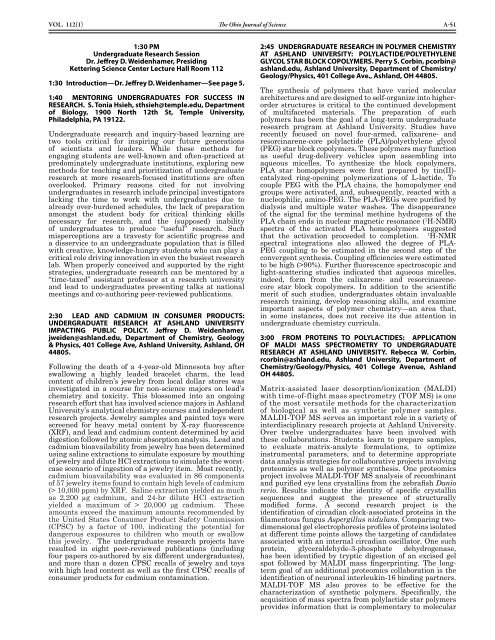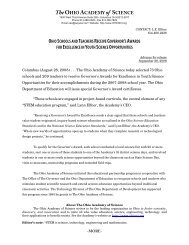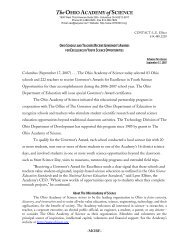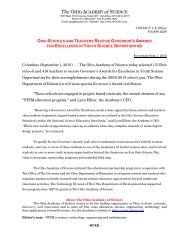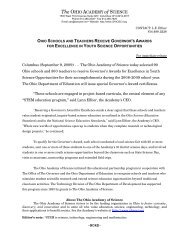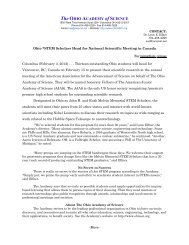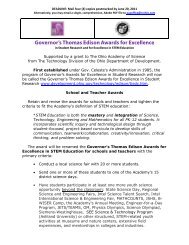The Ohio Journal of - The Ohio Academy of Science
The Ohio Journal of - The Ohio Academy of Science
The Ohio Journal of - The Ohio Academy of Science
Create successful ePaper yourself
Turn your PDF publications into a flip-book with our unique Google optimized e-Paper software.
Vol. 112(1)<br />
1:30 PM<br />
Undergraduate Research Session<br />
Dr. Jeffrey D. Weidenhamer, Presiding<br />
Kettering <strong>Science</strong> Center Lecture Hall Room 112<br />
1:30 Introduction—Dr. Jeffrey D. Weidenhamer—See page 5.<br />
1:40 MENTORING UNDERGRADUATES FOR SUCCESS IN<br />
RESEARCH. S. Tonia Hsieh, sthsieh@temple.edu, Department<br />
<strong>of</strong> Biology, 1900 North 12th St, Temple University,<br />
Philadelphia, PA 19122.<br />
Undergraduate research and inquiry-based learning are<br />
two tools critical for inspiring our future generations<br />
<strong>of</strong> scientists and leaders. While these methods for<br />
engaging students are well-known and <strong>of</strong>ten-practiced at<br />
predominately undergraduate institutions, exploring new<br />
methods for teaching and prioritization <strong>of</strong> undergraduate<br />
research at more research-focused institutions are <strong>of</strong>ten<br />
overlooked. Primary reasons cited for not involving<br />
undergraduates in research include principal investigators<br />
lacking the time to work with undergraduates due to<br />
already over-burdened schedules, the lack <strong>of</strong> preparation<br />
amongst the student body for critical thinking skills<br />
necessary for research, and the (supposed) inability<br />
<strong>of</strong> undergraduates to produce “useful” research. Such<br />
misperceptions are a travesty for scientific progress and<br />
a disservice to an undergraduate population that is filled<br />
with creative, knowledge-hungry students who can play a<br />
critical role driving innovation in even the busiest research<br />
lab. When properly conceived and supported by the right<br />
strategies, undergraduate research can be mentored by a<br />
“time-taxed” assistant pr<strong>of</strong>essor at a research university<br />
and lead to undergraduates presenting talks at national<br />
meetings and co-authoring peer-reviewed publications.<br />
2:30 LEAD AND CADMIUM IN CONSUMER PRODUCTS:<br />
UNDERGRADUATE RESEARCH AT ASHLAND UNIVERSITY<br />
IMPACTING PUBLIC POLICY. Jeffrey D. Weidenhamer,<br />
jweiden@ashland.edu, Department <strong>of</strong> Chemistry, Geology<br />
& Physics, 401 College Ave, Ashland University, Ashland, OH<br />
44805.<br />
Following the death <strong>of</strong> a 4-year-old Minnesota boy after<br />
swallowing a highly leaded bracelet charm, the lead<br />
content <strong>of</strong> children’s jewelry from local dollar stores was<br />
investigated in a course for non-science majors on lead’s<br />
chemistry and toxicity. This blossomed into an ongoing<br />
research effort that has involved science majors in Ashland<br />
University’s analytical chemistry courses and independent<br />
research projects. Jewelry samples and painted toys were<br />
screened for heavy metal content by X-ray fluorescence<br />
(XRF), and lead and cadmium content determined by acid<br />
digestion followed by atomic absorption analysis. Lead and<br />
cadmium bioavailability from jewelry has been determined<br />
using saline extractions to simulate exposure by mouthing<br />
<strong>of</strong> jewelry and dilute HCl extractions to simulate the worstcase<br />
scenario <strong>of</strong> ingestion <strong>of</strong> a jewelry item. Most recently,<br />
cadmium bioavailability was evaluated in 86 components<br />
<strong>of</strong> 57 jewelry items found to contain high levels <strong>of</strong> cadmium<br />
(> 10,000 ppm) by XRF. Saline extraction yielded as much<br />
as 2,200 µg cadmium, and 24-hr dilute HCl extraction<br />
yielded a maximum <strong>of</strong> > 20,000 µg cadmium. <strong>The</strong>se<br />
amounts exceed the maximum amounts recommended by<br />
the United States Consumer Product Safety Commission<br />
(CPSC) by a factor <strong>of</strong> 100, indicating the potential for<br />
dangerous exposures to children who mouth or swallow<br />
this jewelry. <strong>The</strong> undergraduate research projects have<br />
resulted in eight peer-reviewed publications (including<br />
four papers co-authored by six different undergraduates),<br />
and more than a dozen CPSC recalls <strong>of</strong> jewelry and toys<br />
with high lead content as well as the first CPSC recalls <strong>of</strong><br />
consumer products for cadmium contamination.<br />
<strong>The</strong> <strong>Ohio</strong> <strong>Journal</strong> <strong>of</strong> <strong>Science</strong> A-51<br />
2:45 UNDERGRADUATE RESEARCH IN POLYMER CHEMISTRY<br />
AT ASHLAND UNIVERSITY: POLYLACTIDE/POLYETHYLENE<br />
GLYCOL STAR BLOCK COPOLYMERS. Perry S. Corbin, pcorbin@<br />
ashland.edu, Ashland University, Department <strong>of</strong> Chemistry/<br />
Geology/Physics, 401 College Ave., Ashland, OH 44805.<br />
<strong>The</strong> synthesis <strong>of</strong> polymers that have varied molecular<br />
architectures and are designed to self-organize into higherorder<br />
structures is critical to the continued development<br />
<strong>of</strong> multifaceted materials. <strong>The</strong> preparation <strong>of</strong> such<br />
polymers has been the goal <strong>of</strong> a long-term undergraduate<br />
research program at Ashland University. Studies have<br />
recently focused on novel four-armed, calixarene- and<br />
resorcinarene-core polylactide (PLA)/polyethylene glycol<br />
(PEG) star block copolymers. <strong>The</strong>se polymers may function<br />
as useful drug-delivery vehicles upon assembling into<br />
aqueous micelles. To synthesize the block copolymers,<br />
PLA star homopolymers were first prepared by tin(II)catalyzed<br />
ring-opening polymerizations <strong>of</strong> L-lactide. To<br />
couple PEG with the PLA chains, the homopolymer end<br />
groups were activated, and, subsequently, reacted with a<br />
nucleophilic, amino-PEG. <strong>The</strong> PLA-PEGs were purified by<br />
dialysis and multiple water washes. <strong>The</strong> disappearance<br />
<strong>of</strong> the signal for the terminal methine hydrogens <strong>of</strong> the<br />
PLA chain ends in nuclear magnetic resonance ( 1 H-NMR)<br />
spectra <strong>of</strong> the activated PLA homopolymers suggested<br />
that the activation proceeded to completion. 1 H-NMR<br />
spectral integrations also allowed the degree <strong>of</strong> PLA-<br />
PEG coupling to be estimated in the second step <strong>of</strong> the<br />
convergent synthesis. Coupling efficiencies were estimated<br />
to be high (>90%). Further fluorescence spectroscopic and<br />
light-scattering studies indicated that aqueous micelles,<br />
indeed, form from the calixarene- and resorcinarenecore<br />
star block copolymers. In addition to the scientific<br />
merit <strong>of</strong> such studies, undergraduates obtain invaluable<br />
research training, develop reasoning skills, and examine<br />
important aspects <strong>of</strong> polymer chemistry—an area that,<br />
in some instances, does not receive its due attention in<br />
undergraduate chemistry curricula.<br />
3:00 FROM PROTEINS TO POLYLACTIDES: APPLICATION<br />
OF MALDI MASS SPECTROMETRY TO UNDERGRADUATE<br />
RESEARCH AT ASHLAND UNIVERSITY. Rebecca W. Corbin,<br />
rcorbin@ashland.edu, Ashland University, Department <strong>of</strong><br />
Chemistry/Geology/Physics, 401 College Avenue, Ashland<br />
OH 44805.<br />
Matrix-assisted laser desorption/ionization (MALDI)<br />
with time-<strong>of</strong>-flight mass spectrometry (TOF MS) is one<br />
<strong>of</strong> the most versatile methods for the characterization<br />
<strong>of</strong> biological as well as synthetic polymer samples.<br />
MALDI-TOF MS serves an important role in a variety <strong>of</strong><br />
interdisciplinary research projects at Ashland University.<br />
Over twelve undergraduates have been involved with<br />
these collaborations. Students learn to prepare samples,<br />
to evaluate matrix-analyte formulations, to optimize<br />
instrumental parameters, and to determine appropriate<br />
data analysis strategies for collaborative projects involving<br />
proteomics as well as polymer synthesis. One proteomics<br />
project involves MALDI-TOF MS analysis <strong>of</strong> recombinant<br />
and purified eye lens crystallins from the zebrafish Danio<br />
rerio. Results indicate the identity <strong>of</strong> specific crystallin<br />
sequences and suggest the presence <strong>of</strong> structurally<br />
modified forms. A second research project is the<br />
identification <strong>of</strong> circadian clock-associated proteins in the<br />
filamentous fungus Aspergillus nidulans. Comparing twodimensional<br />
gel electrophoresis pr<strong>of</strong>iles <strong>of</strong> proteins isolated<br />
at different time points allows the targeting <strong>of</strong> candidates<br />
associated with an internal circadian oscillator. One such<br />
protein, glyceraldehyde-3-phosphate dehydrogenase,<br />
has been identified by tryptic digestion <strong>of</strong> an excised gel<br />
spot followed by MALDI mass fingerprinting. <strong>The</strong> longterm<br />
goal <strong>of</strong> an additional proteomics collaboration is the<br />
identification <strong>of</strong> neuronal interleukin-16 binding partners.<br />
MALDI-TOF MS also proves to be effective for the<br />
characterization <strong>of</strong> synthetic polymers. Specifically, the<br />
acquisition <strong>of</strong> mass spectra from polylactide star polymers<br />
provides information that is complementary to molecular


